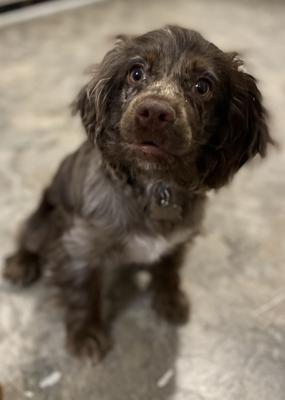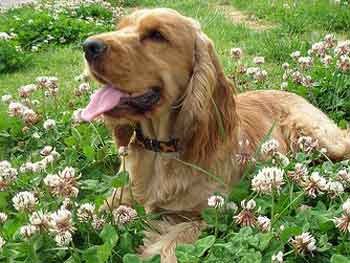- Home
- Dog Fleas and Ticks
Getting Rid of Dog Fleas and Ticks
Getting rid of dog fleas and ticks can be challenging!
If you've seen dog fleas jumping and crawling around in your Cocker Spaniel's coat, I guarantee they'll also be in your home and soft furnishings. But don't worry; there's no need to panic!
You need to understand more about fleas and their life cycle if you are to successfully banish these pesky parasites from your pet and your home for good. This FREE online guide to tick and flea control will help you clean up your Cocker Spaniel AND your home.
Getting rid of dog fleas and ticks can be challenging!
If you've seen dog fleas hopping around in your Cocker Spaniel's coat, I guarantee they'll also be in your home and soft furnishings. But don't panic!
This FREE guide to tick and flea control will help you banish these pests for good!
Dog Fleas and Ticks
It's an understatement to say ticks and fleas are not very nice, especially if you're squeamish about bugs and creepy crawlies. However, it's almost inevitable that at some point, your Cocker will pick up canine parasites, such as ticks, fleas or ear mites.
You'll need a different approach to removing and treating dog ticks than you do to eliminate fleas. Let's deal with them one at a time.
The Dog Flea's Life Cycle
Before you begin getting rid of fleas on your dog, it's helpful to understand the flea's life cycle; otherwise, they will keep coming!
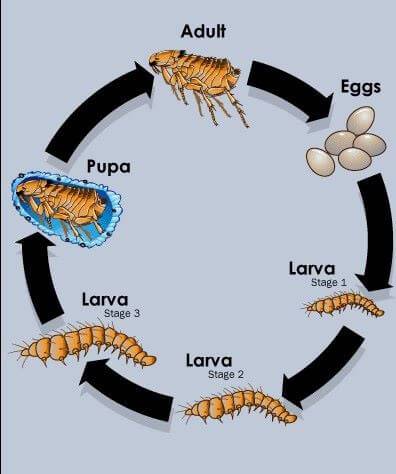 The life cycle of dog fleas
The life cycle of dog fleasThere are four stages to their life cycle: adult, eggs, larvae, and pupae.
Simply killing the adult fleas isn't enough to get rid of them because even if you kill them all, given the right conditions, eggs already laid on your Cocker will hatch, and any larvae and pupae will continue to grow and eventually become adult dog fleas.
These fleas will then feed, mate, and the female will lay her eggs...and the infestation will begin all over again.
Learn more about the dog flea's life cycle, habitat and how to ensure they're eliminated at all stages.
Getting Rid of Fleas on Your Pet
You may be horrified if you discover parasites on your pet; however, it's a fact of doggy life, and we must learn to deal with them.
Ticks and fleas can pass on Lyme disease and cause skin problems, tapeworms and allergies.
Prevention is always better than cure to keep your dog healthy, but if you've already found them, getting rid of the fleas on your Cocker Spaniel should be your first priority.
However, you can't stop there.
You will need a systematic approach to breaking the flea's life cycle to stop the adult fleas from breeding and the eggs, larvae and pupa from developing.
So, get rid of fleas on your dog, then treat your home; your dog's bed and bedding, soft furnishings and carpets.
Natural Tick and Flea Control for Dogs
You can protect your Cocker with a tick or flea treatment your vet prescribes or buy flea control at good pet stores. There are also natural flea treatments if you prefer a less medicated alternative.
However, you might prefer a more natural flea control for dogs, which can be just as effective. You'll find plenty of safe home remedies to choose from, but I recommend you check with your vet that the one you choose is suitable for your Cocker Spaniel.
Flea medication must be correctly applied to be fully effective for your pet; otherwise, it would be a waste of your hard-earned cash!
And take heed, if you find fleas on your dog, you can almost guarantee you'll find fleas in your home too!
So, time to act!
Fleas In The House
Getting rid of fleas in the house requires a firm plan if you are to successfully rid your home of these parasites!
This is because where there is evidence of fleas, you will also find immature fleas, eggs, larvae, and pupae in your home (remember the dog flea life cycle?).
You will find fleas deep in the pile of your carpets, soft furnishings, under the edges of your furniture, and cracks and crevices throughout your home.
Dog Fleas In Your Carpets
Getting rid of fleas in your carpets will need your special attention.
It may take a little longer to find and eliminate the various forms of this parasite currently lodged in the fibres of your carpets and favourite rugs.
You must continue treating your pet AND home until you're confident they're both clear; only then can you relax!
What Do Fleas Look Like?
First of all, let's take a closer look at them, shall we?
Ctenocephalides Canis, more commonly known to you and me as the humble dog flea, can undoubtedly make your Cocker's life a misery, not to mention yours!
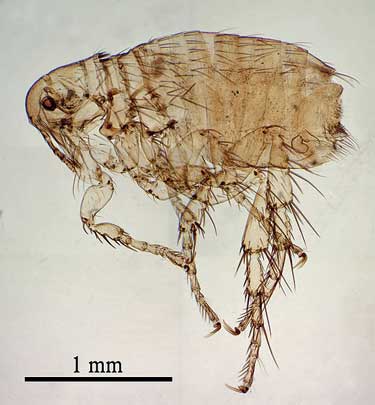 Dog Flea Photo Copyright: Wikipedia
Dog Flea Photo Copyright: WikipediaUnfortunately, at some point in your Spaniel's life, it's almost inevitable that he'll play host to these annoying little parasites.
Dog fleas are so tiny that you can't see them in detail.
This is why most dog owners know a flea when they see one but don't actually know what they really look like; they can't describe them in any detail.
Follow the link for a closer look at one of these critters; they're not a pretty sight, so you've been warned!
Fleas can cause intense itching and scratching (which can lead to hair loss and infection), tapeworms, anaemia and flea allergy dermatitis.
If your pet is infested with dog fleas (even if he's only picked up a couple), it won't take long before it becomes a flea infestation. Once that happens, you'll need to work immediately to eliminate them.
It's essential that you understand their life cycle and habitat to help you banish your dog's unwanted hitchhikers.
Flea Bites On Humans And Dogs
Flea bites are puncture wounds that the flea inflicts when feeding on your Cocker's blood (or yours, for that matter!).
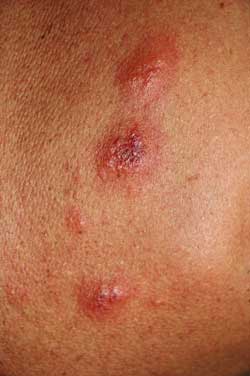 Bad Reaction to Flea Bites
Bad Reaction to Flea BitesThese wounds appear as red blotches and may become inflamed and/or swollen; they can also be annoyingly itchy!
This allergic reaction is caused by an enzyme in the flea's saliva, which causes irritation and an uncontrollable desire to scratch, and scratch, and scratch!
If the bites become infected, they will almost certainly need treatment.
Flea bites on humans or our pets are no joke, as they can, and often do, make our lives miserable!
How To Find and Remove Dog Ticks Safely
Dog ticks are another parasite you should be aware of, especially if you walk your Cocker Spaniel through grassy fields and woods.
You may find your pet picks up a couple of these beasties, particularly in the summer months, so you'll need to learn how to manage these little blighters too.
Dog ticks are small crab-like critters that can grow to the size of a small fingernail after they've fed on your dog's blood!
Besides being unpleasant, they can harbour Lyme disease, too, so it's essential to check your pet for ticks after every walk!
Follow the link to learn more about dog ticks:
- What diseases can they pass on?
- How best to find them on your Cocker?
- How to remove them safely and quickly.
- How to protect your Cocker Spaniel from them in the first place.
Stay vigilant; regularly check your pet for ticks to help keep your dog healthy!
Banishing Dog Fleas and Ticks: Tips
Check your Cocker's coat regularly for evidence of dog fleas and ticks, such as dried blood, eggs and adult fleas.
Also, watch your dog for tell-tale scratching; always a giveaway!
Grooming your pet weekly will allow you to check your Cocker's coat for parasites and help you spot and treat an infestation before it becomes a problem.
I often take a quick look through Max's coat each evening when he's lying quietly; I stoke him, but I also have a good old root around. It only takes a few minutes, and I can act relatively quickly if I find something lurking!
Photo Credits for Dog Fleas and Ticks:
1. Wikipedia - https://en.wikipedia.org/wiki/Dog_flea
2. Copyright unknown
3. Copyright of About-Cocker-Spaniels.com

